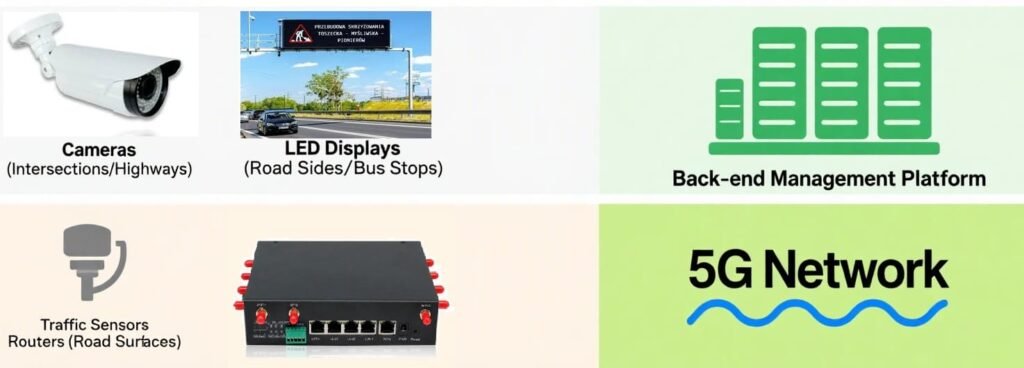5G enables smart traffic management
1. Introduction to Smart Traffic and 5G industrial router Advantages
Smart traffic systems aim to optimize urban mobility, reduce congestion, and enhance road safety through real-time data collection, analysis, and dynamic guidance. However, traditional network solutions (e.g., wired connections or 4G) often struggle with high latency, limited bandwidth, and poor flexibility—critical bottlenecks for time-sensitive traffic management.
5G industrial routers address these challenges by leveraging 5G’s core strengths: ultra-low latency (≤10ms), high bandwidth (up to 2Gbps), and massive device connectivity. These features enable seamless integration of real-time monitoring devices, sensors, and traffic guidance LEDs, forming a responsive and adaptive smart traffic ecosystem.
2. Key Applications in Smart Traffic
2.1 Real-Time Traffic Monitoring
5G industrial routers serve as the backbone for connecting high-definition (HD) cameras and AI-powered sensors at intersections, highways, and urban hotspots.
- High-Speed Data Transmission: HD cameras capturing vehicle flow, pedestrian movement, and incidents (e.g., accidents, jaywalking) generate large volumes of data. 5G industrial routers transmit this data to a central traffic management platform in real time, eliminating delays that could hinder timely decision-making.
- Low-Latency Remote Control: Traffic management centers can remotely adjust camera angles or zoom in on critical areas via 5G industrial routers, ensuring continuous oversight of dynamic traffic conditions. For example, during peak hours, operators can prioritize monitoring highway on-ramps to detect and mitigate potential bottlenecks early.
- Redundancy and Reliability: 5G industrial routers support dual SIM cards and automatic network switching, ensuring uninterrupted monitoring even if one 5G signal weakens—critical for maintaining surveillance in areas with fluctuating network coverage.
2.2 Sensor Network Integration
Smart traffic systems rely on a dense network of sensors (e.g., loop detectors, weather sensors, and vehicle speed sensors) to collect granular data. 5G industrial routers enable efficient, scalable connectivity for these devices:
- Massive IoT Connectivity: A single 5G industrial routercan connect hundreds of sensors within a radius, making it ideal for large-scale deployments (e.g., across an entire downtown district). This eliminates the need for multiple wired connections, reducing installation costs and complexity.
- Real-Time Data Aggregation: Sensors transmit data (e.g., vehicle count, average speed, or road surface temperature) to 5G industrial routers, which aggregate and send it to the cloud for analysis. For instance, weather sensors detecting heavy rain can trigger the system to adjust speed limits displayed on traffic LEDs, enhancing safety.
- Edge Computing Support: Advanced 5G industrial routers with edge computing capabilities can process sensor data locally (e.g., counting vehicles at an intersection) and send only critical insights to the central platform, reducing bandwidth usage and latency.
2.3 Traffic Guidance LED Screens
5G industrial routers enable dynamic and responsive control of LED traffic guidance screens, which display real-time information (e.g., travel times, detour alerts, or lane closures) to drivers:
- Instant Content Updates: Traffic management centers can update LED screen content (e.g., “Accident Ahead: Use Alternative Route”) via 5G industrial routers in seconds. This is far faster than traditional methods (e.g., manual updates or 4G networks), ensuring drivers receive timely guidance.
- Targeted Information Delivery: 5G industrial routers allow segmentation of LED screens by location. For example, highway LED screens can display toll information, while urban screens focus on public transit updates, ensuring relevant messages reach the right audience.
- Remote Diagnostics: 5G industrial routers monitor the status of LED screens (e.g., power levels, pixel functionality) and send alerts to maintenance teams if issues arise (e.g., a dimmed screen). This reduces downtime and ensures continuous operation of critical guidance tools.
3. Network Architecture
The 5G-based smart traffic network architecture consists of three layers:
- Device Layer: Includes HD cameras, sensors, and LED screens, all connected to 5G industrial routers via Wi-Fi or Ethernet.
- Network Layer: 5G industrial routers transmit data to a central traffic management platform using 5G networks, with secure encryption to protect against cyber threats.
- Application Layer: The platform analyzes data to generate insights (e.g., congestion predictions) and sends commands back to devices (e.g., updating LED screens) via 5G industrial router

Use case: R5000 5G industrial router used in Saudi Arabia Traffic Control
4. Benefits and Implementation Considerations
4.1 Benefits
- Improved Traffic Flow: Real-time data enables proactive congestion management, reducing commute times by up to 30% in pilot cities.
- Enhanced Safety: Rapid incident detection and LED alerts minimize accident risks, particularly in adverse weather or high-traffic scenarios.
- Cost Efficiency: 5G industrial routers reduce reliance on wired infrastructure, cutting installation and maintenance costs by 40% compared to traditional systems.
4.2 Implementation Considerations
- 5G Coverage: Ensure consistent 5G signal in urban canyons or remote highways by deploying small cells or repeaters.
- Security: Implement end-to-end encryption and secure authentication for 5G industrial routers to prevent unauthorized access to traffic data.
- Scalability: Choose routers with modular designs to support future additions of sensors or LED screens as the system expands.
5. Conclusion
5G industrial routers are a transformative technology for smart traffic systems, enabling real-time monitoring, seamless sensor integration, and dynamic control of traffic guidance LEDs. By leveraging 5G’s speed, low latency, and reliability, cities can build more efficient, safe, and adaptive transportation networks—paving the way for smarter urban mobility.
